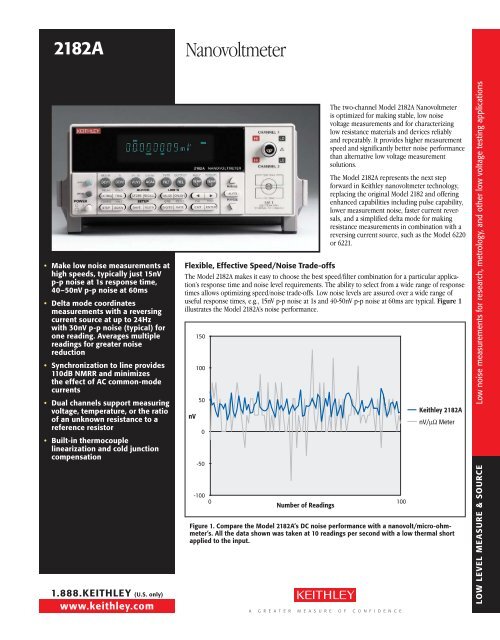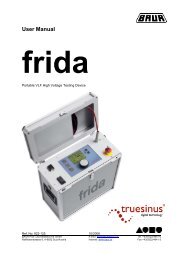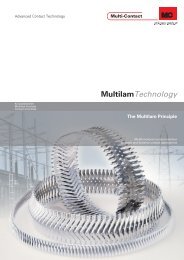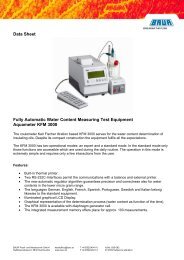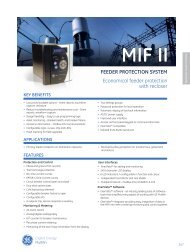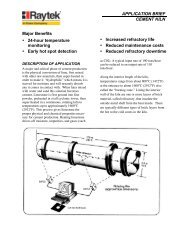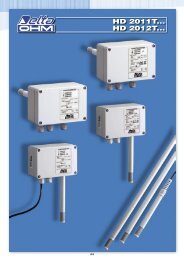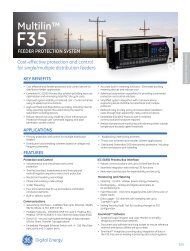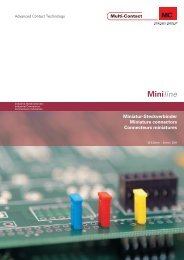Nanovoltmeter - Belmet
Nanovoltmeter - Belmet
Nanovoltmeter - Belmet
Create successful ePaper yourself
Turn your PDF publications into a flip-book with our unique Google optimized e-Paper software.
2182A<br />
<strong>Nanovoltmeter</strong><br />
• Make low noise measurements at<br />
high speeds, typically just 15nV<br />
p-p noise at 1s response time,<br />
40–50nV p-p noise at 60ms<br />
• Delta mode coordinates<br />
measurements with a reversing<br />
current source at up to 24Hz<br />
with 30nV p-p noise (typical) for<br />
one reading. Averages multiple<br />
readings for greater noise<br />
reduction<br />
• Synchronization to line provides<br />
110dB NMRR and minimizes<br />
the effect of AC common-mode<br />
currents<br />
• Dual channels support measuring<br />
voltage, temperature, or the ratio<br />
of an unknown resistance to a<br />
reference resistor<br />
• Built-in thermocouple<br />
linearization and cold junction<br />
compensation<br />
1.888.KEITHLEY (U.S. only)<br />
www.keithley.com<br />
The two-channel Model 2182A <strong>Nanovoltmeter</strong><br />
is optimized for making stable, low noise<br />
voltage measurements and for characterizing<br />
low resistance materials and devices reliably<br />
and repeatably. It provides higher measurement<br />
speed and significantly better noise performance<br />
than alternative low voltage measurement<br />
solutions.<br />
The Model 2182A represents the next step<br />
forward in Keithley nanovoltmeter technology,<br />
replacing the original Model 2182 and offering<br />
enhanced capabilities including pulse capability,<br />
lower measurement noise, faster current reversals,<br />
and a simplified delta mode for making<br />
resistance measurements in combination with a<br />
reversing current source, such as the Model 6220<br />
or 6221.<br />
Flexible, Effective Speed/Noise Trade-offs<br />
The Model 2182A makes it easy to choose the best speed/filter combination for a particular application’s<br />
response time and noise level requirements. The ability to select from a wide range of response<br />
times allows optimizing speed/noise trade-offs. Low noise levels are assured over a wide range of<br />
useful response times, e.g., 15nV p-p noise at 1s and 40-50nV p-p noise at 60ms are typical. Figure 1<br />
illustrates the Model 2182A’s noise performance.<br />
nV<br />
150<br />
100<br />
50<br />
0<br />
-50<br />
-100<br />
0 100<br />
Number of Readings<br />
Figure 1. Compare the Model 2182A’s DC noise performance with a nanovolt/micro-ohmmeter’s.<br />
All the data shown was taken at 10 readings per second with a low thermal short<br />
applied to the input.<br />
A G R E A T E R M E A S U R E O F C O N F I D E N C E<br />
Keithley 2182A<br />
nV/µΩ Meter<br />
Low noise measurements for research, metrology, Side Text and other low voltage testing applications<br />
LOW LEVEL MEASURE & SOURCE
2182A<br />
<strong>Nanovoltmeter</strong><br />
Low noise measurements for research, metrology, Side Text and other low voltage testing applications<br />
Ordering Information<br />
2182A<br />
<strong>Nanovoltmeter</strong><br />
Accessories Supplied<br />
2107-4 Low Thermal Input Cable<br />
with spade lugs, 1.2m (4 ft).<br />
User manual, service<br />
manual, contact cleaner,<br />
line cord, alligator clips.<br />
Accessories Available<br />
2107-30 Low Thermal Input Cable with spade lugs,<br />
9.1m (30 ft)<br />
2182-KIT Low Thermal Connector with strain relief<br />
2187-4 Low Thermal Test Lead Kit<br />
2188 Low Thermal Calibration Shorting Plug<br />
4288-1 Single Fixed Rack Mount Kit<br />
4288-2 Dual Fixed Rack Mount Kit<br />
7007-1 Shielded GPIB Cable, 1m (3.2 ft)<br />
7007-2 Shielded GPIB Cable, 2m (6.5 ft)<br />
7009-5 Shielded RS-232 Cable, 1.5m (5 ft)<br />
8501-1 Trigger Link Cable, 1m (3.2 ft)<br />
8501-2 Trigger Link Cable, 2m (6.5 ft)<br />
8502 Trigger Link Adapter to 6 female BNC connectors<br />
8503 Trigger Link Cable to 2 male BNC connectors<br />
KPCI-488LPA IEEE-488 Interface/Controller for the PCI Bus<br />
KUSB-488B IEEE-488 USB-to-GPIB Interface Adapter<br />
Services Available<br />
2182A-3Y-EW 1-year factory warranty extended to 3 years<br />
from date of shipment<br />
C/2182A-3Y-ISO 3 (ISO-17025 accredited) calibrations within 3<br />
years of purchase*<br />
TRN-LLM-1-C Course: Making Accurate Low-Level<br />
Measurements<br />
* Not available in all countries<br />
Reliable Results<br />
Power line noise can compromise measurement accuracy significantly at the nanovolt level. The<br />
Model 2182A reduces this interference by synchronizing its measurement cycle to line, which<br />
minimizes variations due to readings that begin at different phases of the line cycle. The result is<br />
exceptionally high immunity to line interference with little or no shielding and filtering required.<br />
Optimized for Use with Model 6220/6221 Current Sources<br />
Device test and characterization for today’s very small and power-efficient electronics requires sourcing<br />
low current levels, which demands the use of a precision, low current source. Lower stimulus<br />
currents produce lower—and harder to measure—voltages across the devices. Linking the Model<br />
2182A <strong>Nanovoltmeter</strong> with a Model 6220 or 6221 Current Source makes it possible to address both of<br />
these challenges in one easy-to-use configuration.<br />
When connected, the Model 2182A and Model 6220 or 6221 can be operated like a single instrument.<br />
Their simple connections eliminate the isolation and noise current problems that plague other solutions.<br />
The Model 2182A/622X combination allows making delta mode and differential conductance<br />
measurements faster and with less noise than the original Model 2182 design allowed. The Model<br />
2182A will also work together with the Model 6221 to make pulse-mode measurements.<br />
The 2182A/622X combination is ideal for a variety of applications, including resistance measurements,<br />
pulsed I-V measurements, and differential conductance measurements, providing significant<br />
advantages over earlier solutions like lock-in amplifiers or AC resistance bridges. The 2182A/622X<br />
combination is also well suited for many nanotechnology applications because it can measure<br />
resistance without dissipating much power into the device under test (DUT), which would otherwise<br />
invalidate results or even destroy the DUT.<br />
An Easy-to-Use Delta Mode<br />
Keithley originally created the delta mode method for measuring voltage and resistance for the Model<br />
2182 and a triggerable external current source, such as the Model 2400 SourceMeter instrument.<br />
Basically, the delta mode automatically triggers the current source to alternate the signal polarity, and<br />
then triggers a nanovoltmeter reading at each polarity. This current reversal technique cancels out<br />
5nV<br />
LOW LEVEL MEASURE & SOURCE<br />
Applications<br />
Research<br />
• Determining the transition<br />
temperature of superconductive<br />
materials<br />
• I-V characterization of a material<br />
at a specific temperature<br />
• Calorimetry<br />
Metrology<br />
• Intercomparisons of standard<br />
cells<br />
• Null meter for resistance bridge<br />
measurements<br />
1.888.KEITHLEY (U.S. only)<br />
www.keithley.com<br />
4µV<br />
DC<br />
Measurement<br />
Delta Mode<br />
Measurement<br />
Figure 2. Results from a Model 2182A/6220 using the delta mode to measure a 10mW resistor<br />
with a 20µA test current. The free Model 6220/6221 instrument control example start-up<br />
software used here can be downloaded from www.keithley.com.<br />
A G R E A T E R M E A S U R E O F C O N F I D E N C E
2182A NANOVOLTMETER<br />
6220 DC AND AC CURRENT SOURCE<br />
2182A<br />
<strong>Nanovoltmeter</strong><br />
any constant thermoelectric offsets, so the results reflect the true value of<br />
the voltage being measured. The improved delta mode for the Model 2182A<br />
and the Model 622X current sources uses the same basic technique, but the<br />
way in which it’s implemented has been simplified dramatically. The new<br />
technique can cancel thermoelectric offsets that drift over time (not just<br />
static offsets), produces results in half the time of the original technique,<br />
and allows the current source to control and configure the Model 2182A.<br />
Two key presses are all that’s required to set up the measurement. The<br />
improved cancellation and higher reading rates reduce measurement noise<br />
to as little as 1nV.<br />
Differential Conductance Measurements<br />
Characterizing non-linear tunneling devices and low temperature devices<br />
often requires measuring differential conductance (the derivative of a<br />
device’s I-V curve). When used with a Model 622X current source, the<br />
Model 2182A is the industry’s fastest, most complete solution for differential<br />
conductance measurements, providing 10X the speed and significantly<br />
lower noise than other instrumentation options. There’s no need to<br />
average the results of multiple sweeps, because data can be obtained in a<br />
single measurement pass, reducing test time and minimizing the potential<br />
for measurement error.<br />
Pulsed Testing with the Model 6221<br />
When measuring small devices, introducing<br />
even tiny amounts of heat to the DUT can raise<br />
its temperature, skewing test results or even<br />
destroying the device. When used with the<br />
Model 2182A, the Model 6221’s pulse capability<br />
100µs<br />
0.5µA<br />
minimizes the amount of power dissipated into<br />
a DUT. The Model 2182A/6221 combination<br />
synchronizes the pulse and measurement. A<br />
measurement can begin as soon as 16µs after<br />
the Model 6221 applies the pulse. The entire<br />
pulse, including a complete nanovolt measurement,<br />
can be as short as 50µs.<br />
In the delta, differential conductance, and pulse<br />
modes, The Model 2182A produces virtually no transient currents, so it’s<br />
ideal for characterizing devices that can be easily disrupted by current spikes<br />
(see Figure 4).<br />
Metrology Applications<br />
The Model 2182A combines the accuracy of a digital multimeter with<br />
low noise at high speeds for high-precision metrology applications. Its<br />
low noise, high signal observation time, fast measurement rates, and<br />
2ppm accuracy provide the most cost-effective meter available today for<br />
applications such as intercomparison of voltage standards and direct<br />
measurements of resistance standards.<br />
Nanotechnology Applications<br />
The Model 2182A combined with the Model 622X current source or Series<br />
2400 SourceMeter ® instrument is a highly accurate and repeatable solution<br />
for measuring resistances on carbon nanotube based materials and silicon<br />
nanowires.<br />
1.888.KEITHLEY (U.S. only)<br />
www.keithley.com<br />
Model 2182A<br />
RS-232<br />
Trigger Link<br />
DUT<br />
Model 622X<br />
Figure 3. It’s simple to connect the Model 2182A to the Model<br />
6220 or 6221 to make a variety of measurements. The instrument<br />
control example start-up software available for the Model 622X<br />
current sources includes a step-by-step guide to setting up the<br />
instrumentation and making proper connections.<br />
Competition 2182A 2182A in delta mode<br />
A G R E A T E R M E A S U R E O F C O N F I D E N C E<br />
GPIB or<br />
Ethernet<br />
Figure 4. The Model 2182A produces the lowest transient currents of any nanovoltmeter available.<br />
Research Applications<br />
The Model 2182A’s 1nV sensitivity, thermoelectric EMF cancellation, direct<br />
display of “true” voltage, ability to perform calculations, and high measurement<br />
speed makes it ideal for determining the characteristics of materials<br />
such as metals, low resistance filled plastics, and high and low temperature<br />
superconductors.<br />
Low noise measurements for research, metrology, Side Text and other low voltage testing applications<br />
LOW LEVEL MEASURE & SOURCE
2182A<br />
<strong>Nanovoltmeter</strong><br />
Low noise measurements for research, metrology, Side Text and other low voltage testing applications<br />
LOW LEVEL MEASURE & SOURCE<br />
Three Ways to Measure Nanovolts<br />
DC nanovoltmeters. DC nanovoltmeters<br />
and sensitive DMMs both provide low noise<br />
DC voltage measurements by using long<br />
integration times and highly filtered readings<br />
to minimize the bandwidth near DC.<br />
Unfortunately, this approach has limitations,<br />
particularly the fact that thermal voltages<br />
develop in the sample and connections vary,<br />
so long integration times don’t improve<br />
measurement precision. With a noise<br />
specification of just 6nV p-p, the Model 2182A<br />
is the lowest noise digital nanovolt meter<br />
available.<br />
AC technique. The limitations of the long<br />
integration and filtered readings technique<br />
have led many people to use an AC technique<br />
for measuring low resistances and voltages.<br />
In this method, an AC excitation is applied<br />
to the sample and the voltage is detected<br />
syn chronously at the same frequency and<br />
an optimum phase. While this technique<br />
removes the varying DC component, in many<br />
experiments at high frequencies, users can<br />
experience problems related to phase shifts<br />
caused by spurious capacitance or the L/R<br />
time constant. At low frequencies, as the<br />
AC frequency is reduced to minimize phase<br />
shifts, amplifier noise increases.<br />
The current reversal method. The Model<br />
2182A is optimized for the current reversal<br />
method, which combines the advantages of<br />
both earlier approaches. In this technique,<br />
the DC test current is reversed, then the<br />
difference in voltage due to the difference<br />
in current is determined. Typically, this<br />
measure ment is performed at a few hertz (a<br />
frequency just high enough for the current<br />
to be reversed before the thermal voltages<br />
can change). The Model 2182A’s low noise<br />
performance at measurement times of a<br />
few hundred milliseconds to a few seconds<br />
means that the reversal period can be set<br />
quite small in comparison with the thermal<br />
time constant of the sample and the connections,<br />
effectively reducing the impact of<br />
thermal voltages.<br />
1.888.KEITHLEY (U.S. only)<br />
www.keithley.com<br />
220<br />
215<br />
210<br />
205<br />
200<br />
195<br />
190<br />
185<br />
Temperature<br />
(°C)<br />
Voltage<br />
(nV)<br />
180<br />
–10<br />
0 8 17 25 33 42 50 58 67 75 83 92 100 108 117 125<br />
Minutes<br />
Figure 5. The Model 2182A’s delta mode provides extremely stable results, even in the presence<br />
of large ambient temperature changes. In this challenging example, the 200nV signal<br />
results from a 20µA current sourced by a Model 6221 through a 10mW test resistor.<br />
Optional Accessory: Model 2187-4 Low Thermal<br />
Test Lead Kit<br />
The standard cabling provided with the Model<br />
2182A Nano volt meter and Model 622X Current<br />
Sources provides everything normally needed<br />
to connect the instruments to each other and to<br />
the DUT. The Model 2187-4 Low Thermal Test<br />
Lead Kit is required when the cabling provided<br />
may not be sufficient for specific applications,<br />
such as when the DUT has special connection<br />
requirements. The kit includes an input cable<br />
with banana terminations, banana extensions,<br />
sprung-hook clips, alligator clips, needle probes,<br />
and spade lugs to accommodate virtually any<br />
DUT. The Model 2187-4 is also helpful when the<br />
DUT has roughly 1GW impedance or higher.<br />
In this case, measuring with the Model 2182A<br />
Figure 6. Model 2187-4 Test Lead Kit<br />
directly across the DUT will lead to loading<br />
errors. The Model 2187-4 Low Thermal Test Lead Kit provides a banana cable and banana jack<br />
extender to allow the Model 2182A to connect easily to the Model 622X’s low impedance guard<br />
output, so the Model 2182A can measure the DUT voltage indirectly. This same configuration also<br />
removes the Model 2182A’s input capacitance from the DUT, so it improves device response time,<br />
which may be critical for pulsed measurements.<br />
Figure 7. Model 2182A rear panel<br />
A G R E A T E R M E A S U R E O F C O N F I D E N C E<br />
30<br />
25<br />
20<br />
15<br />
10<br />
5<br />
0<br />
–5
2182A<br />
<strong>Nanovoltmeter</strong><br />
Volts Specifications (20% over range)<br />
Conditions: 1PLC with 10 reading digital filter or 5PLC with 2 reading digital filter.<br />
Accuracy: ±(ppm of reading + ppm of range)<br />
(ppm = parts per million) (e.g., 10ppm = 0.001%)<br />
Temperature<br />
Channel 1 Input 24 Hour 1 90 Day 1 Year 2 Year Coefficient<br />
Range Resolution Resistance T CAL<br />
±1°C T CAL<br />
±5°C T CAL<br />
±5°C T CAL<br />
±5°C 0°–18°C & 28°–50°C<br />
10.000000 mV 2, 3, 4 1 nV >10 GW 20 + 4 40 + 4 50 + 4 60 + 4 (1 + 0.5)/°C<br />
100.00000 mV 10 nV >10 GW 10 + 3 25 + 3 30 + 4 40 + 5 (1 + 0.2)/°C<br />
1.0000000 V 100 nV >10 GW 7 + 2 18 + 2 25 + 2 32 + 3 (1 + 0.1)/°C<br />
10.000000 V 1 µV >10 GW 2 + 1 5 18 + 2 25 + 2 32 + 3 (1 + 0.1)/°C<br />
100.00000 V 4 10 µV 10 MW ±1% 10 + 3 25 + 3 35 + 4 52 + 5 (1 + 0.5)/°C<br />
Channel 2<br />
6, 10<br />
100.00000 mV 10 nV >10 GW 10 + 6 25 + 6 30 + 7 40 + 7 (1 + 1 )/°C<br />
1.0000000 V 100 nV >10 GW 7 + 2 18 + 2 25 + 2 32 + 3 (1 + 0.5)/°C<br />
10.000000 V 1 µV >10 GW 2 + 1 5 18 + 2 25 + 2 32 + 3 (1 + 0.5)/°C<br />
CHANNEL 1/CHANNEL 2 RATIO: For input signals ≥1% of the range, Ratio Accuracy =<br />
±{[Channel 1 ppm of Reading + Channel 1 ppm of Range * (Channel 1 Range/Channel 1 Input)] + [Channel 2 ppm of Reading + Channel 2 ppm of Range * (Channel 2 Range/Channel 2 Input)]}.<br />
DELTA (hardware-triggered coordination with Series 24XX, Series 26XXA, or Series 622X current sources for low noise R measurement):<br />
Accuracy = accuracy of selected Channel 1 range plus accuracy of I source range.<br />
DELTA measurement noise with 6220 or 6221: Typical 3nVrms / Hz (10mV range) 21 . 1Hz achieved with 1PLC, delay = 1ms, RPT filter = 23 (20 if 50Hz).<br />
PULSE-MODE (with 6221): Line synchronized voltage measurements within current pulses from 50µs to 12ms, pulse repetition rate up to 12Hz.<br />
Pulse measurement noise (typical rms noise, R DUT<br />
2182A<br />
<strong>Nanovoltmeter</strong><br />
LOW LEVEL MEASURE & SOURCE<br />
Model Model 2182A Side specifications<br />
Text<br />
Measurement Characteristics<br />
A/D Linearity: ±(0.8ppm of reading + 0.5ppm of range).<br />
Front Autozero Off Error<br />
10mV–10V: Add ±(8ppm of range + 500µV) for


